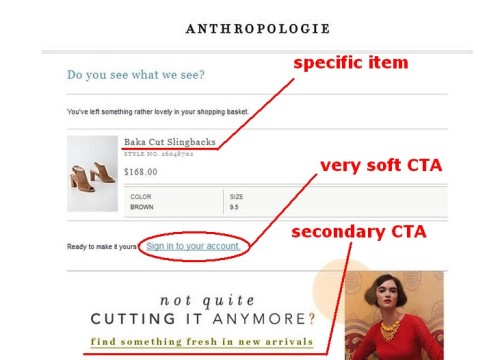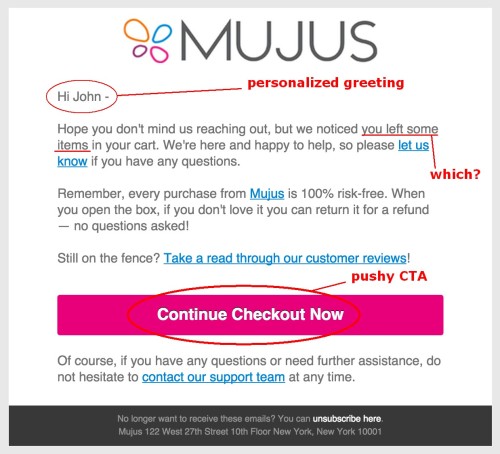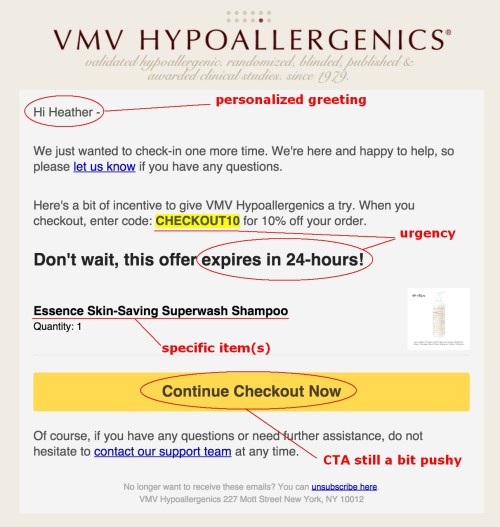4 Data-Driven Strategies to Increase Your Email Conversions
Sep 28th, 2016

Email is the lifeblood of any online business, including e-commerce. Most online stores don’t utilize its full potential, however, inundating customers with frequent, poorly targeted email blasts.
We have all seen those. Newsletter-like messages featuring rows upon rows of products that are irrelevant to subscribers. Announcements about deals and sales that seem to happen every week. Generic, ineffective tactics like those make open and click-through rates plummet, and the bottom line soon follows.
This feels all the more unfair, considering that online stores practically swim in useful customer data that can be applied to increase email conversions. Let’s look at how you can integrate those stats to make every email count — and generate revenue.
1. Use Highly Targeted Behavioral Campaigns
Designing email marketing for your ecommerce business, choose quality and personalization over quantity. Janrain’s Online Personal Experience Study released in 2013 says that 74% of customers strongly dislike getting marketing offers that have nothing to do with their interests.
People leave sites because they are shown wrong ads; they don’t buy or even unsubscribe when sent irrelevant emails. The message is clear.
Does this mean you should stop sending scheduled email campaigns altogether? Of course not — but getting highly specific and targeted in your approach to them will do wonders for your conversion rates. And it starts with behavioral email marketing.
Who does it well: to find a perfect example of behavioral emails, look no further than Airbnb. They keep careful track of every customer’s browsing behavior, and send highly personalized, friction-free and friendly emails like this one (source: Getvero.com blog).
This is what email marketing for ecommerce should be like. And that’s why I urge you to use customer data to increase email conversions — the results speak for themselves.
How you can do it: integrating email data with web tracking of customer behavior is the first and most important step. It used to be a daunting task, but nowadays any good marketing automation system does it automatically. Ecommerce-focused email marketing providers such as Klaviyo also have this functionality.
Once your customer data is tied to your email list, you can do sophisticated marketing without too much effort. For example, you can take a staple of ecommerce email marketing — cart abandonment notifications — and make them 10 times more compelling.
2. Improve Cart Abandonment Emails
Sending customers cart abandonment emails is a common practice — according to an aggregate study by Baymard Institute, 55-80% of shoppers abandon their carts (on average).
Reclaiming those sales is essential. However, it’s not enough to simply write, “There are X items in your shopping cart” and stick a checkout button in the email. Here’s how to instantly improve your cart abandonment notifications:
- make them personalized — clearly display the items that the customer forgot in the cart;
- make them urgent — say that the inventory is limited, throw in time-sensitive free shipping or a bonus with purchase;
- make them desirable — highlight 1-2 items that the customer browsed previously, or that are similar to those in the cart
- make them actionable — add a clear call-to-action that takes people straight into their shopping cart, with the goods on display and ready for checkout.
Note: although many businesses do this, I firmly believe that offering customers a discount to help the purchase along is a terrible idea in the long term. It conditions people to expect discounts and bargain-hunt, ultimately hurting your bottom line. The incentives listed above are more than enough.
Who does it well: Anthropologie sends personalized, actionable cart abandonment emails that don’t feel pushy. They check all the boxes:

How you can do it: look at your cart abandonment emails and consult the list above. Even by introducing one change, like a personalized subject line, you can boost your click-through rates by anywhere from 10% to 25% (according to this case study).

and has a very pushy call to action.

It’s personalized, specific and urgent
3. Harness The Power Of Past Purchases
People who have already bought from you are the most likely to do it again. Simple and obvious as it sounds, many brands neglect this useful insight.
A well-timed email that introduces a highly relevant recommendation based on a past purchase is an excellent way to generate more sales. With the power of customer data, it has become easier than ever to accomplish.
Who does it well: Amazon — just look at the screenshot below. It’s not even a “salesy” email — all it does is urge the customer to learn more about other interesting items. After all, if they have bought something in that category and loved it, they might want more — and probably do.

How you can do it: There are several ways to take advantage of a customer’s purchasing history. You can use it for all sorts of things:
- promote similar items from other brands;
- highlight complementary goods they might use in combination with the earlier purchase;
- turn their attention to similar items currently on sale;
- offer to buy a related item as a gift for someone.
Past buyers are your most valued asset — sending them recommendations like these is a great strategy to maximize repeat purchases and revenue-per-customer.
4. Urge Them To Buy What They Already Want
If a customer has viewed an item in your store several times, or adds it to their wishlist, it means they would like to pick it up. Certainly not right then and there, but in the near future.
Browsing and 'wishlisting’ indicate that customers research different options. The question is, how can a business use this to make a sale? I recommend using urgency, scarcity, and timing to nudge your customers towards a sale.
- urgency — when an item they want goes on sale, send them an email about it;
- scarcity — when the stock on something they want is about to run out, let them know;
- timing — when a customer is making frequent visits to your site, or when a holiday is coming up, give them a friendly reminder that basically says, “You wanted this — why not pick it up now?”
Who does it well: I have to mention Amazon again. They have got it down to science, and send behavioral emails triggered both by repeated browsing and 'wishlisting’ of items.
Normally, blindly copying an ecommerce giant’s tactics is a bad idea, since your businesses are on such different playing fields, but strategies #3 and #4 will work for any online store.

How you can do it: even if your store doesn’t have a wishlist, you can take advantage of a customer’s browsing history, past purchases and current preferences to send sophisticated 'nudge’ emails that make great use of all that we’ve talked about: urgency, scarcity, and timing.
Email marketing is vital to an ecommerce business — it’s the best way to reconnect with past customers, most of whom would forget about you otherwise. I am not exaggerating, by the way: in a massive study of 600,000 users, PracticalEcommerce found out that out of your first-time buyers, only 5% will return to the site, and just 3% will make a repeat purchase. Unless, of course, you help them along.
In terms of reconnecting with past buyers and getting conversions and sales out of email marketing, nothing beats the combo of smart emails and customer data. It’s more accessible than ever, too — you can create a free Klaviyo account right now and start sending smarter, more personalized ecommerce emails today. And that means bigger profits tomorrow!



